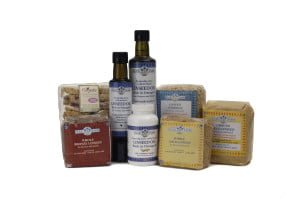Whole Linseed
Flax Farm whole linseed
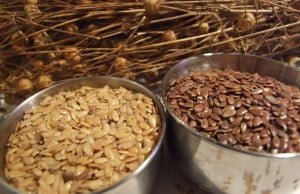
Why choose whole linseed
Linseed (also called flaxseed) is a great source of excellent nutrients. Kept cool and dry it has a very long shelf-life of well over a year. For health purposes and to benefit from its amazing nutritional properties it is best ground but can also be nice added to foods whole.
- You want to grind it fresh yourself
- You want whole seeds for adding to bread, baking or breakfasts
- You want it for drinks or ethnic recipes
- It has a long shelf life useful if you don’t use it regularly and want to know you always have some in stock.
Great nutrients
It has a unique balance of important nutrients:
- omega-3 (alpha linolenic fatty acid, ALA)
- dietary fibre both soluble and insoluble fibre,
- protein
- lignans and polyphenols
For many people what it doesn’t contain is just as important:
- Wheat-free, grain-free
- Gluten-free
- Starch-free
- Low in available carbohydrate
Uses for whole linseed
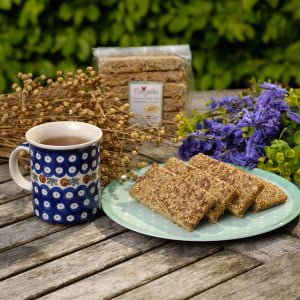
Whole linseeds are great for:
- Flavour
- Decoration in bread and baking
- Texture
- Snacks
- Adding to breakfasts and yoghurt
- An ingredient in traditional recipes
- A great ingredient for everyday foods
- As porridge
- Egg replacer
- Dairy/fat replacer in baking
- Grind them yourself for fresh ground linseed
- They have a long shelf life; keep a pack in the cupboard for recipes and remedies
What is whole linseed good for?
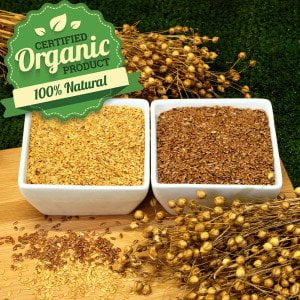 Remember whole linseed should be ground to get the most benefit.
Remember whole linseed should be ground to get the most benefit.
- Omega-3 which supports healthy cholesterol levels
- Boiled in water it makes mucilaginous tummy-friendly soothing drink
- Healthy digestion
- whole linseeds are a rich source of fibre; try in your diet to support the digestion
- A useful alternative food for special diets
- wheat-free, gluten-free, sugar-free, starch-fee, dairy-free
Whole linseeds add interest, flavour, texture and roughage to your diet but to get the best nutritional benefit from linseed it should be ground, especially if you have a sensitive digestion.
A traditional superfood and remedy
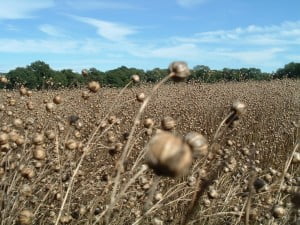
Whole linseeds (flaxseeds) are tough little capsules of strength and vitality grown as an annual crop, Linum usitatissimum. It is grown throughout much of the of the world including the UK. Linseeds are small seeds slightly larger than sesame seeds, the shape of flattened apple pips and usually dark brown in colour.
When growing, linseed (flax) has blue (or occasionally white) flowers. The seeds develop in small papery seed-heads or capsules. each containing 10 seeds. As the seeds ripen the capsules turn light brown and dry.
Linseed (flaxseed) has been used as a food for at least 15,000 years and as a natural remedy recorded thousands of years ago in Ancient Babylon. Today in the West linseed is becoming increasingly popular as a food and remedy in alternative medicine as it provides a rich source of some important nutrients that the Western diet is deficient in and is a natural food antidote to our modern over-refined foods.
Linseed or flax?
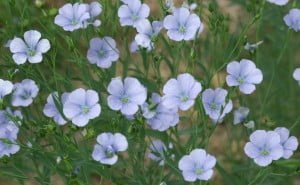
The name Linum usitatissimum means the useful linum which refers to the many uses man has found for the plant. The fibre (flax) is used to make fine, strong high quality, thread, rope, fabric (linen) and sailcloth; the linseeds (flaxseeds) are used as food, natural remedies and for oil.
There is some confusion around the name of this superfood. Health food shops often use the name ‘flax’ because that is what they call it in North America. In the UK flax is the name for the strains of the plant used for making linen and the varieties used for food or oil are called ‘linseed’. At Flax Farm we call it linseed because that is the traditional UK name.
Varieties of linseed
Colour
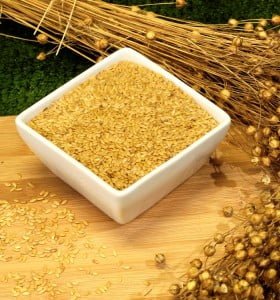
Linseed (flaxseed) is available in two main colours, brown and gold, with many different shades of each. There are many varieties of brown and gold linseed: there is no connection between colour and nutrient/health properties and there is no difference between gold and brown linseed.
Varieties
Flax Farm: GM-free
Linseed (flax) has been developed by natural selection for many thousands of years. Since the development of technology for GM foods, some varieties of linseed grown in other countries, including Canada and China, are genetically modified. One variety called Triffid was grown in Canada and in turn has contaminated linseed (flaxseed) stocks in many other countries around the world. Read more
These GM-foods are indistinguishable; the only way to be safe is to buy UK-grown or organic linseed (flax). Flax Farm is passionate about non-GM; all Flax Farm linseed is always GM-free.
Rich in omega-3
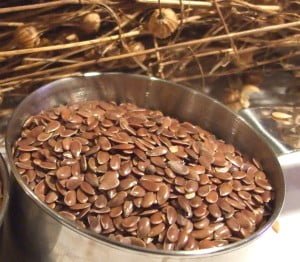 Solin or Linola and some other varieties of linseed have been bred to contain little or no omega-3; they do not have the nutritional benefits of ordinary linseed. They have been bred for use in processed foods and deep fat frying. These varieties of linseed lacking omega-3 are mostly grown in Canada and China. The varieties of linseed/flax bred to have low omega-3 can be brown or gold.
Solin or Linola and some other varieties of linseed have been bred to contain little or no omega-3; they do not have the nutritional benefits of ordinary linseed. They have been bred for use in processed foods and deep fat frying. These varieties of linseed lacking omega-3 are mostly grown in Canada and China. The varieties of linseed/flax bred to have low omega-3 can be brown or gold.
All the varieties of linseed from Flax Farm are conventional high omega-3 varieties.
Taste
Linseed tastes lightly creamy, buttery, mildly nutty. (If you have a nut allergy don’t worry: linseed is not a nut; it is a seed and nut-free.) The dark brown varieties of linseed generally taste nuttier and more distinctly of linseed. The gold linseed is milder and grassier in flavour.
Use recommendations
- Whole linseed is best ground to get the maximum nutritional benefits (you need to use a dedicated electric coffee/spice mill). If grinding the linseed isn’t convenient try Flax Farm freshly ground linseed.
- Add into everyday meals.
- Always drink at least one extra large glass of water when eating linseed.
- If you find whole linseeds difficult to digest you can still get the benefits from Flax Farm’s range of foods based on ground linseed and cold-pressed oil. See Flax Farm ground linseed and Flax Farm cold-pressed linseed oil too.
How to use whole linseed (flax)
Like most linseed foods,whole linseed (flaxseed) needs no cooking skill; just munch the seeds as they are, sprinkle or stir into food and drinks.
How much to have?
Add to drinks or food. Typically use 2 tablespoons up to three times per day for acute conditions. If using for constipation and improvement is not noticed within 24 hours you should consult your doctor.
As an everyday food, 2 dessertspoons of whole or ground linseed once or twice per day in food and drinks. Linseed is more nutritious and effective for health if ground. Drink an extra glass of water with every helping,
More things to you can do with whole linseeds
- Add to fudge and toffees
- Put it in savoury and sweet muffins
- Dry roast and sprinkle on salads
- Dry roast with sesame seeds for a healthy snack to nibble
- Make clear linseed tea
- Use in flax crackers
- Extract the mucilage and make hair care products,
- Use whole linseeds in soothing eyepads
Things you can do when you have ground the whole linseeds
For maximum nutritional benefit linseed is best ground.
- Stir into soup, porridge, cereal.
- Add to smoothies
- Add to rhubarb and other cooked or fresh fruit
- Use as a gluten-free flour
- Make gluten-free bread
- Make lovely flax crackers
Loads more recipes for whole and ground linseed on our recipe pages,
Flax Farm’s other linseed produce includes
- Ground linseed
- Cold-pressed linseed oil
- Linseed porridge and muesli
- Linseed Flaxjacks®

Flax farm Products

